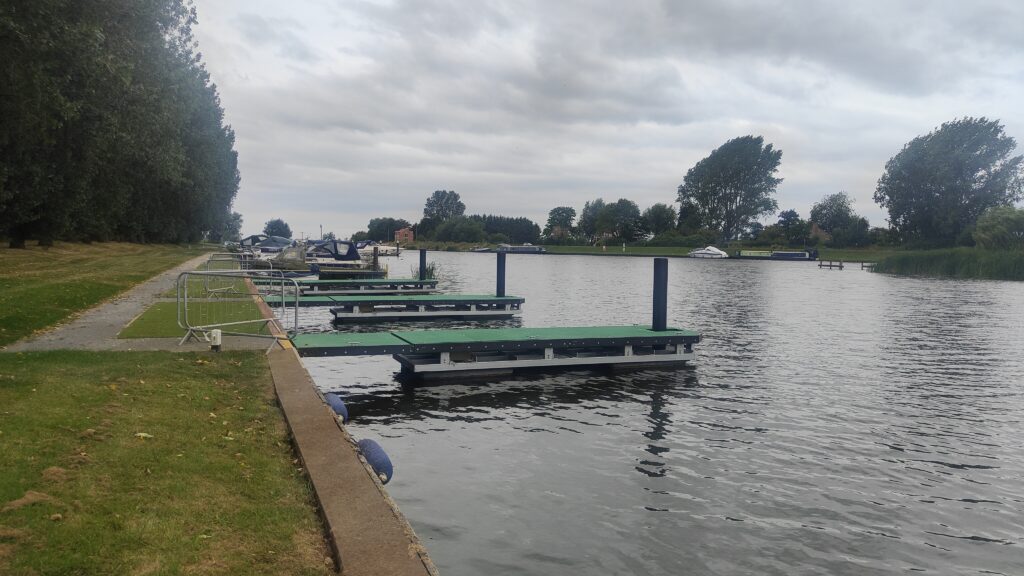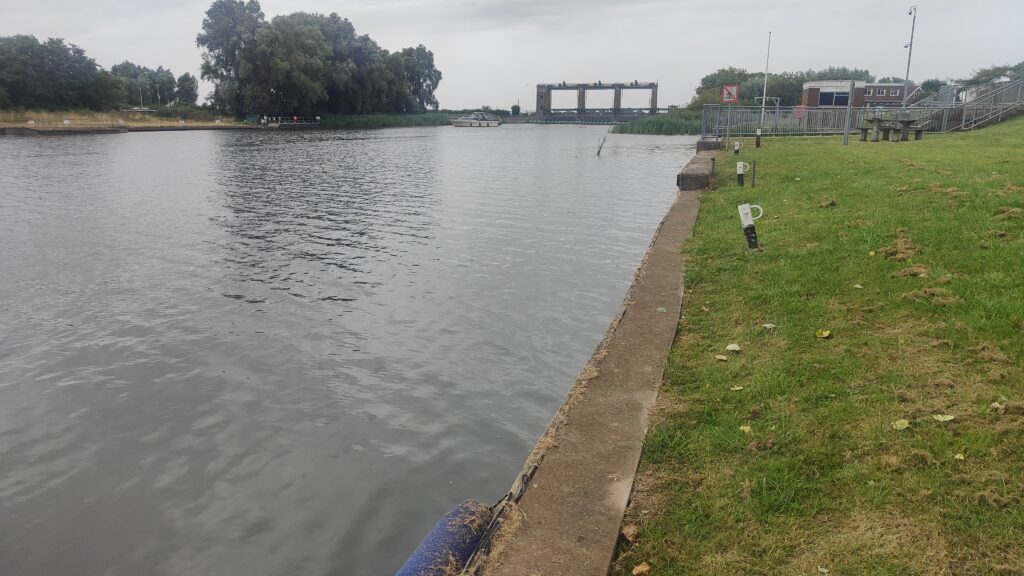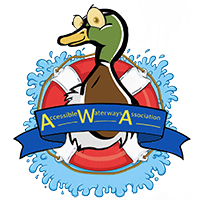AWA meets EA
Thursday 8 August 2024
Denver Complex, Norfolk

What a refreshing experience! We (Tim and Tracey) were invited along to the impressive Denver Complex on the River Great Ouse Relief Channel, near Downham Market in Norfolk. This was to meet with several key personnel from the Environment Agency, who are invested in developing the accessibility of EA moorings and facilities.

The day was refreshing in the sense that we were actively invited, our input was sought, our thoughts and ideas well enthusiastically welcomed. It even rained lightly to refresh us just in the few minutes that we went outside to view the existing and planned moorings!
We started off with informal chatting over a light lunch. This was largely introductions, but led naturally into some good conversations about the whole topic of accessibility of our waterways, what AWA is all about, and what EA wants to be able to achieve. The EA folk were very interested in our Boaters’ Blue Card scheme, and want to roll it out onto their waters. Tracey now needs to get on with compiling an information pack and education campaign to all lock keepers, volunteers and staff of all waterways.
We have to say that we are impressed and greatly encouraged by the EA’s ideas and ambitions with regard to accessibility.
EA are aiming to extend and develop their existing moorings at Denver to add in several designated ‘Accessible Moorings’ on both banks of the water. On the site visit, we discussed the pros and cons of various options put forward. There is already a stretch of finger moorings of varying length. One section of these is constructed of floating short finger-pontoons, against a solid wharf. This is edged with the big crenelated piling. The other is a series of finger-pontoons along a floating pontoon wharf with a much greater range of vertical movement to work with the rising and falling water levels.

We discussed the possibilities for accessible sites and concluded that a linear mooring on a floating pontoon would be most suitable. This would allow for the fluctuating water levels, maintaining a stable transit height between boat and platform. This would be of a good width with non-slip surface and a ramp leading between pontoon and land. This, of course will inevitably vary in gradient dependent upon inclement water levels; an unavoidable natural challenge on rivers.

One idea that really impressed us is that of movable railings. This would be a system of portable railings that could be taken from site to site and installed upon request, according to the needs of individual boaters. They would be invaluable to many boaters who experience difficulties with unprotected edges (for example perhaps those with balance or coordination challenges). This is yet to be explored more fully, but we are hugely encouraged by the forward thinking of EA on this. Practicalities will need to be balanced, but we discussed the possible options of these being either pre-installed by EA staff at a booked mooring upon request, or perhaps a set of railings being available to hire and then installed, by the boater themselves (or a crew-mate), at each mooring (where fixings are available) as needed. This would be dependent upon the means of fixing and installing. It really is just an idea at the moment, but a very good idea in our opinion!
We then visited the other end of that range of moorings, where the boats are tied to finger-pontoons jutting perpendicular to a linear floating platform. Here we noted the excellent non-slip small-gauge grid surface pontoon (mini-mesh GRP) of excellent width. This allows for ample space to manoeuvre even the biggest powered wheelchair or mobility scooter. The finger pontoons are also a good width, although perhaps too narrow to allow for a large mobility vehicle to turn comfortably to and from a boat ramp. (If this is a requirement, then a linear mooring would be better than a finger pontoon.)
There are good railings along the land-side edge of the linear pontoon here. If the removable barriers could be developed and added along the waterside then that would be superb.
Land-access to and from these moorings is also planned for improvement. The EA have installed a very wide wooden gate, with intentions to add a hedgerow adjacent to it, to restrict vehicular access to authorised users only. (There is a gravel car park nearby for use by other boaters). There will be a properly surfaced driveway and car-parking area next to the accessible moorings.
We discussed at length the design for the accessible mooring bollard, developed by AWA and Canal & River Trust, as well as the blue-print for the placing of them in context of a designated Accessible Mooring site. The consensus of opinion is that this is very appealing and workable. If these bollards are incorporated into the planned mooring areas, then this would prove an excellent test-site for the beginning of a nationwide roll-out of the project.
Part of our aim is to roll this out as a ‘national standard’ across all of the UK’s Inland Waterways, regardless of which authority looks after it. Maybe it could also become a standard in our coastal harbours too.
Of course, all of this is dependent upon funding, and nobody has yet found a magic money tree. But, the EA seem to have a positive attitude toward this and talk of ‘where there is a will, there is a way’. They fully acknowledge the absolutely obligatory need to make their sites as accessible as possible for everybody equally. They are also mindful that provision of accessible structures, facilities and environments usually attracts extra funding opportunities.
So, overall, this was a very worthwhile and refreshing day!

